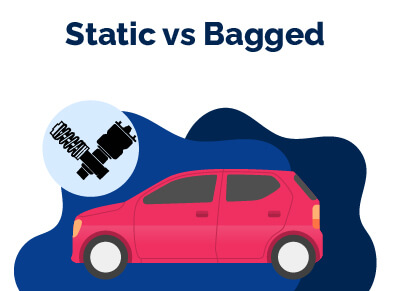Static vs. Bagged Suspension Systems (Full Comparison)
July 25, 2023


Chris is Head of Content for FindTheBestCarPrice and is based out of Philadelphia, PA. As a seasoned automotive industry analyst and car enthusiast, he ensures the highest level of quality across all our content and curates our picks for the best deals each month.
Chris studied information systems and marketing at Drexel University and writes about a wide range of topics ranging from car buying tips to troubleshooting common mechanical issues.
When he’s not thinking about cars, he likes to stay in with his dog and make an “attempt” to finish a crossword puzzle (he’s not quite at the Saturday/Sunday level…yet). As a former cheesemonger, Chris still has a “sharp” passion for all things cheese, and his fridge is always loaded with it!
Chris also has a passion for things that go fast, and drones are no exception. He spends some of his time writing for Dronesourced.
When it comes to customizing cars, there are many different options to choose from. Two popular choices are static and bagged suspension systems.
Static suspension is a traditional method of lowering a car, using aftermarket springs or coilovers to lower the car's ride height. Bagged suspension, on the other hand, uses airbags to adjust the car's ride height on the fly.
Here at FindTheBestCarPrice, our team has not only researched but also gotten their hands dirty with both systems, understanding the nitty-gritty of what works best under different hoods and on various roads. We've seen firsthand the impact each choice has on a car's performance and aesthetics.
So let’s explore the differences between static and bagged suspension systems, including the pros and cons of each option. We will also provide tips on how to choose the right suspension system for your car and what factors to consider when making your decision.
Table of Contents
What Is Static Stance?
A static suspension lowers the car permanently with aftermarket parts, bringing it closer to the ground.
This setup often requires additional modifications like camber/caster plates and extended strut tops to work properly.
The biggest benefit is the lower ride height, giving the car a more aggressive look.
It also improves traction by increasing the tire contact area, which helps with cornering.
However, this comes with downsides, such as faster wear on tires and suspension parts, and more road noise from less space between the tires and fenders.
Pros and Cons
Pros:
Enhanced Handling: Improves drivers' control and makes driving more enjoyable.
Reduced Body Roll: Keeps the car more stable during turns.
Lowered Center of Gravity: Contributes to the improved handling and stability.
Increased Tire Lifespan: A larger contact patch area reduces tire wear.
Aggressive Appearance: The lower ride height offers a more impressive look.
Cons:
Not Suitable for Off-Roading: The rigid setup and lower clearance limit off-road capabilities.
Increased Wear on Suspension: The static stance can lead to more rapid wear and tear on suspension components.
Reduced Ground Clearance: Makes it difficult to navigate bumps or large obstacles.
Risk of Understeer: Some vehicles may experience understeer, which can increase the chance of an accident during fast turns.
What Is Bagged Stance?
Bagged stance, also known as air suspension, uses air-powered components to adjust a vehicle's height. This setup includes components like an airbag compressor, pressure switch, valves, and airbags for each corner of the car.
The primary advantage of this system is its versatility in adjusting ride height on demand. This flexibility is beneficial for increasing clearance or reducing drag, depending on the situation. Air suspensions tend to offer a smoother ride compared to static setups due to the airbags' ability to better absorb bumps.
However, air suspensions require regular maintenance to prevent leaks and can be more expensive due to the high-quality components involved.
Pros and Cons
Pros:
Adjustable Ride Height: Enables on-the-fly adjustments for different needs.
Comfortable Ride: Provides a smoother experience by absorbing road imperfections.
Enhanced Stability: Improves safety on winding roads and in adverse conditions.
Increased Dynamic Stability: Makes handling more agile, especially in turns.
Aesthetic Appeal: Offers a customized, lowered look with improved aerodynamics, potentially enhancing performance and fuel efficiency.
Cons:
Higher Cost: More expensive than traditional suspensions due to complex components.
Maintenance Needs: Requires regular checks for leaks and upkeep.
Increased Wear and Tear: The additional weight of the system may lead to faster degradation of vehicle parts.
Seating Discomfort in Traffic: Adjusting seating position can be challenging in prolonged stationary or slow-moving conditions.
Differences Between Static and Bagged
Having covered the fundamental principles of static and bagged suspension systems, let us delve deeper into the dissimilarities that set them apart.
1. How Both Work
The fundamental difference between the two suspension systems is primarily their operating principles.
Static suspension employs conventional or coil springs to hold the vehicle's weight, whereas bagged suspension utilizes airbags.
The springs in static suspension systems disperse the vehicle's kinetic energy, preventing excessive bouncing after encountering a bump.
Conversely, airbags in bagged suspension systems compress and expand to absorb impacts when a bump is hit.
2. Cost
Typically, the price of a bagged suspension system exceeds that of a static suspension system due to the former's increased intricacy and higher installation labor costs.
However, the heightened expense may be justifiable if you desire a more comfortable ride.
Remember that regular upkeep, such as replacing leaked or damaged airbags, necessitates budgeting.
On average, a static suspension system can be purchased for roughly $500, while a bagged suspension system may cost more than $2,000.
Therefore, a static suspension system may be more economical if cost is a significant concern.
3. Working Parts
Another salient distinction is complexity. The static suspension system is characterized by having fewer mobile components than the bagged one. As a result, the static suspension system is often more dependable and straightforward to upkeep.
Over time, the airbags in the bagged suspension system may experience leaks, threatening the suspension's durability.
Also, airbags are vulnerable to operational malfunctioning when subjected to excessive pressure, which is not a concern with springs. Overall, a static suspension system is more straightforward and reliable than a bagged one.
4. Application
Bagged suspension systems are commonly favored in larger vehicles like RVs, off-road vehicles, and buses as they can deliver a more comfortable ride experience during extended travel.
On the other hand, static suspension systems are more prevalent in smaller vehicles like cars and pickup trucks, albeit there are exceptions to this convention.
A few drivers may opt for the smoother ride provided by a static suspension system, even in larger vehicles, ultimately choosing between the two options a matter of individual taste.
5. Adjustability
In contrast, a bagged suspension system provides greater flexibility and adaptability regarding ride height, stiffness, and dampening.
Compared to a static suspension system, adjusting a bagged system is relatively easy since it requires only an adjustment of the air pressure rather than physically replacing the springs.
While replacing springs in a static suspension system is not challenging, it requires more time and effort than adjusting a bagged system.
Therefore, a bagged suspension system is more versatile and offers more adjustability options than a static one.
Static vs. Bagged: Which Is Better?
Static and bagged cars have advantages and disadvantages, and selecting the ideal one for you depends on your specific requirements.
A static car is a vehicle that comes equipped with suspension components from the manufacturer, which usually results in a higher ride height.
That said, it provides numerous benefits, such as better tire wear and improved handling on the road due to its stiffer suspension.
A static car is ideal for the everyday driver who does not require unnecessary handling or performance capabilities.
In contrast, a bagged car refers to a vehicle that has undergone a significant transformation by equipping it with an air-ride suspension system, enabling effortless adjustments to the car's height, allowing drivers to either raise it high off the ground or lower it closer to the pavement, depending on their preference.
This suspension system is perfect for performance and handling because it lets you personalize the vehicle's configuration and alter your ride height to suit your needs.
Bagged cars are better suited for those seeking an aggressive look or who want to take their vehicle to the track.
Ultimately, the optimal vehicle selection hinges upon the precise type of automobile you seek and the intended usage.
Static cars are ideal if you do not require high-performance characteristics but desire a dependable ride that can handle everyday driving conditions.
If you want more customization options and enhanced performance, bagged cars might be a good option.
Notwithstanding their advantages, they also entail certain disadvantages, including but not limited to necessitating more frequent upkeep and exhibiting greater susceptibility to leaks, potentially generating exasperation among motorists.
Bagged cars typically ride more harshly than static cars due to their stiffer suspension setup, which may affect comfort.
Best Car Deals by Category
Posted in Car Buying Tips, Car Troubleshooting |




